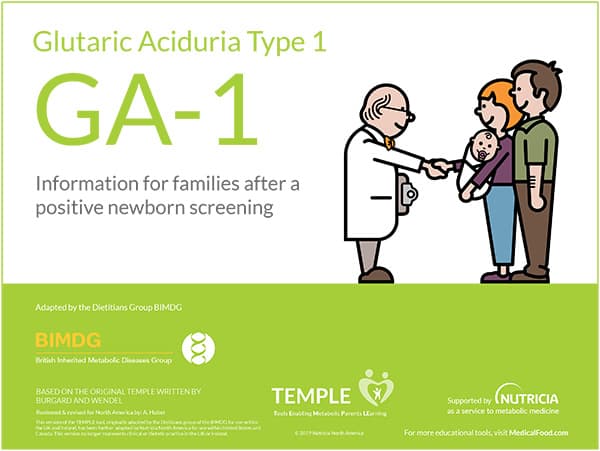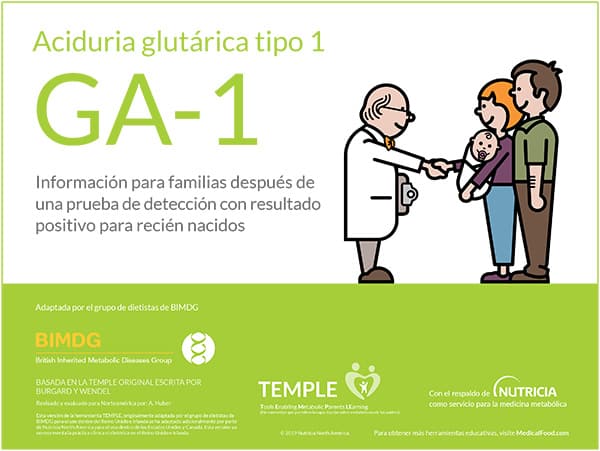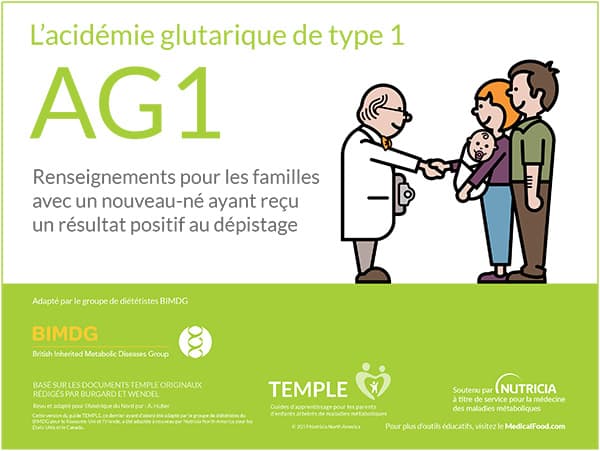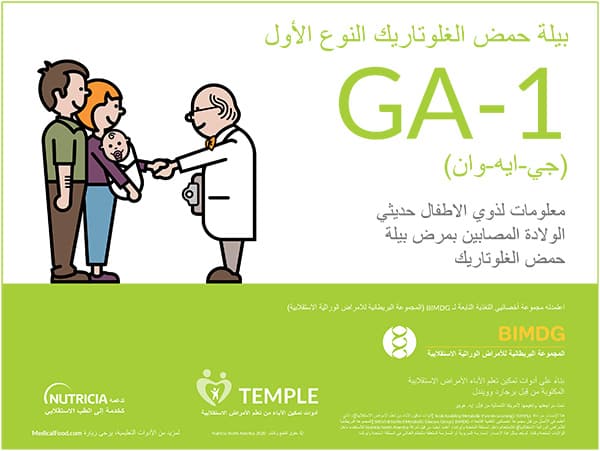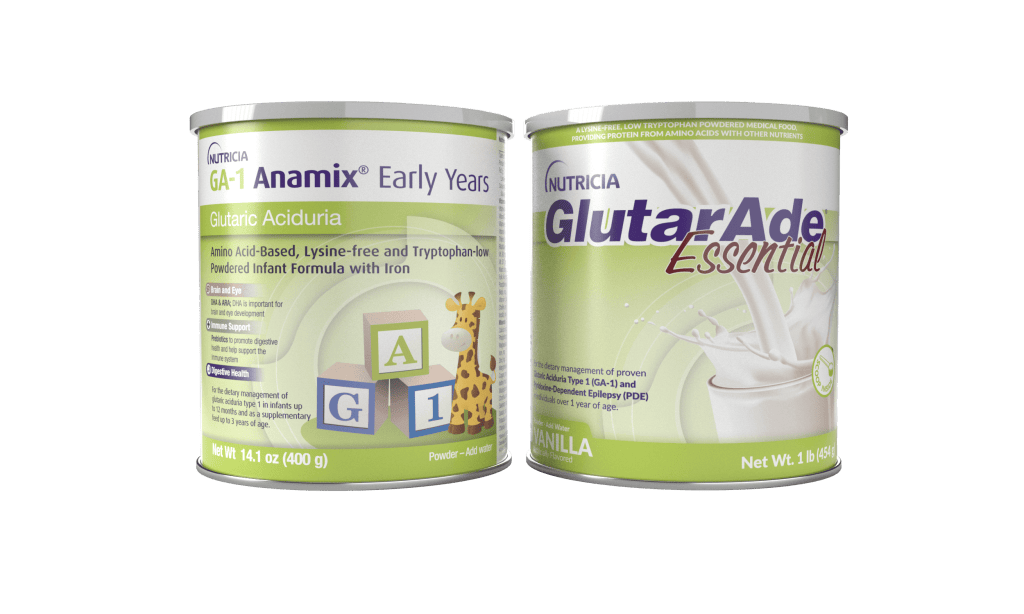GA-1 - Glutaric Aciduria Education & Support
Glutaric aciduria type 1 (GA-1) also called glutaric acidemia type 1, is an inherited, genetic disorder. GA-1 occurs when there is a defect in an enzyme that helps break down protein from food. The name of the enzyme is glutaryl-CoA dehydrogenase (GCDH).
Protein is made up of smaller units called amino acids. Amino acids are important to build muscle and other body tissues for normal growth. Any extra amino acids are normally broken down to produce energy. In GA-1, two of the amino acids cannot be broken down in the body. These amino acids are lysine and tryptophan. When someone with GA-1 eats too much protein from food, does not get enough calories or becomes ill, blood levels of lysine and tryptophan increase and so do levels of glutaric acid, a toxic byproduct. Glutaric aciduria gets its name because of the buildup of glutaric acid that can occur in the blood and urine of people with this disorder.
High levels of glutaric acid are especially dangerous to an infant’s brain. The area of the brain that is most affected, which is called the basal ganglia, controls movement. Thus, affected infants and children can develop spasms and jerking movements with a rigid body posture, especially after a serious illness. Long-term problems can include poor growth, abnormal motor skills, slow development and learning problems.
Finding out that your child has GA-1 can be overwhelming. Fortunately, nutrition management is available to help prevent many of these problems. Take comfort in knowing that your metabolic healthcare team can provide you with the best advice to help manage GA-1.
Incidence, Genetics and Newborn Screening
GA-1 is a rare disorder that occurs in about 1 in every 40,000 births. It occurs more often in the Amish community and Ojibwa population of Canada, affecting about 1 in every 300 births.
GA-1 is inherited as a “recessive disorder.” In recessive disorders, both the mother and father are “carriers,” and they do not have any symptoms of the disorder. With each pregnancy there is a 1 in 4 (25%) chance that the infant will be affected. A genetic counselor can help explain the inheritance of GA-1 and the risks to future infants.
GA-1 can be screened for at birth through a simple blood test. For details on newborn screening (NBS) in the US, visit https://newbornscreening.hrsa.gov/your-state; for information on NBS in Canada, visit https://www.raredisorders.ca/.
There is no cure for GA-1, but it can be managed with a modified diet, medication and special medical formulas specifically designed for persons with GA-1. The modified diet for GA-1 is low in lysine and tryptophan. It is important that an individual with GA-1 continues with management as directed by their healthcare professional.
A medical formula is a very important part of the diet for GA-1. The protein source in GA-1 formulas is individual amino acids, but lysine is left out and tryptophan is added at very low levels to avoid deficiencies. This allows a person with GA-1 to get enough protein without the parts of protein that can be harmful. Medical formulas may also provide calories, vitamins and minerals the body needs for normal growth.
To provide just enough lysine and tryptophan that a person with GA-1 needs, a limited amount of natural protein-containing foods are allowed in the diet. For infants, breast milk or regular infant formula is given in precise amounts. As the baby grows and can eat solid foods, the breast milk or regular infant formula will be removed from the diet, and lysine and most tryptophan will come from foods instead.
Since all foods with protein contain lysine and tryptophan, individuals with GA-1 must limit their intake of foods high in protein. These include milk and dairy products, meat, poultry, fish, eggs, beans, nuts and peanut butter. Regular breads and pastas may be allowed in small amounts, but special low protein versions of these foods are often used instead to allow for more choices in the diet and less concern for eating too much protein. Vegetables and fruit are allowed. Typically, the amount of lysine in the diet is counted. Foods may have to be weighed or measured to ensure that excess lysine is not eaten. A metabolic dietitian will work closely with people with GA-1 to prescribe the best diet plan and help with needed changes in the future.
Nutricia North America provides a range of medical formulas as well as low protein foods. Please contact us for more information. Your dietitian will help you decide which products are best.
In addition to a modified diet, those with GA-1 may also be given L-carnitine. This medication can help reduce the amount of glutaric acid in the blood.
During Illness
During illness or after an injury, the body increases the breakdown of protein stores. This can raise the level of glutaric acid in the blood and lead to serious medical problems. Illness with a fever can be especially harmful. Early signs that require immediate medical attention include vomiting, excessive sleepiness, coordination problems and/or changes in mental status. During any illness, it is very important to notify your metabolic clinic immediately. Often, the diet is adjusted to either remove or decrease protein and increase calories. This can help slow down the breakdown of protein stores. Medications may also be adjusted during illness. Your clinic will give you an emergency letter - if you notice symptoms of high glutaric acid levels, take this letter with you to the emergency room. During an illness, a hospital stay may be needed.
| Screening Technologies and Research in Genetics (STAR-G) |
| Newborn Screening in Your State (US) |
| Organic Acidemia Association |
| Canadian Organization for Rare Disorders |
Nutricia North America would like to thank Sandy van Calcar, PhD, RD, Oregon Health & Science University for her consultation.
Inspiring Stories
GA-1 Education
Tools Enabling Metabolic Parents Learning (TEMPLE)
This easy-to-understand education booklet and video are for families affected by a diagnosis of GA-1. The book and video share the basics of the disorder and the genetics behind GA-1.
Click on the booklet to view and download in your preferred language.
Low Pro Living Support
We have a library of information to help support families like yours throughout the various stages of life's journey. From big moments, like starting college to little ones like what to eat for dinner, we have tips and ideas to help you along the way.

